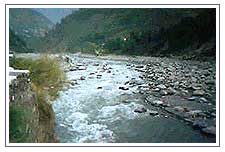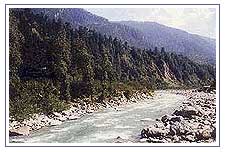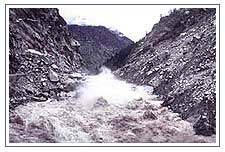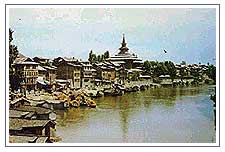
To
the north west of India runs the river Indus. While today most of the Indus
does not flow within India, five tributaries of the Indus drain the Indian
land. Where all five of them run, that area has come to be known as Punjab
or the area of five rivers. The five rivers are Sutlej, Beas, Ravi, Jhelum
and Chenab. These rivers in turn have their tributaries and because of them
the northern part of Indian soil is very fertile.
Each of the five rivers has a mythological reason for its being.
Interestingly most of them have something or other to do with the enmity
between two great sages: Vashishta and Vishwamitra. Although both the seers
were equally well versed in the sacred texts, they often crossed swords due
to the impetuousness of Vishwamitra.
Legend Of River Iravati Or Ravi
The story goes that there was once a
king named Sudasa. For many long years the sage in his court was Vishwamitra
and then Vashishta. When Vashishta was performing all the prayers for the
king, a war broke out and king Sudasa found he had to fight many kings at
the same time. Although king Sudasa was brave, his enemies were brutal. They
decided to dig the course of the river along a route that would harm him and
make it difficult for him to fight. That is how they dug the route of river
Iravati. Vishwamitra was watching with glee. But the King of Kings, Indra
was also watching. He willed just the other way round and the righteous king
Sudasa won because his enemies were drowned in river Iravati. The same river
that was to create a hurdle in king Sudasa's life, became his saviour.
.
River Iravati is now Ravi, a major river of Punjab running a full 450 miles
from its source in the mountains of Bungall, in Rohtang Pass. River Ravi is
hydrates of Arrean, Adris of Ptolemy, Hyarotes of Strabo and Phaudis of
Pliny. In Vedic literature, it has also been called "Purushini" or
"Parushini".
Other Legends Connected To River Ravi
During its early stages, Ravi was also called "Raina". After it
passes by the city of Champa in Himachal Pradesh it acquire the name Ravi.
The waters of Ravi are redder than the adjoining rivers, and it is believed
that the deposits made by the river are very fertile. Ravi moves in a
tortuous channel, and its swift waters are used to carry timber. River Ravi
is fordable eight months of the year. Within a few metres from Chamba the
river meets river Tavi. The two together pass through Gurdaspur and Amritsar
districts of Punjab and finally merge into the waters of river Chenab and
Jhelum.
Vashishta did not come to harm. In fact his reputation grew. Vishwamitra
decided to visit the great sage in his hermitage. When he did, he found that
the sage Vashishta had a cow named "Kamadenu". It laid a feast at
command. When sage Vishwamitra saw this feat, he wanted the cow. Vashishta
refused to give him the cow. Vishwamitra made many excuses. "Please, "
he said, "You better," he threatened. "For God's sake,"
he implored. But Vashishta was unmoved. He said he would not be able to part
with the cow.
Sage Vishwamitra on contemplation found he was left with no other way but
to steal the cow, which he did. But the sage of such wisdom should have
known that if a cow could lay a feast at command, it must be a thinking cow,
unlike the magic objects that jack of beanstalk fame found. But blinded by
desire, as Vishwamitra was, he did not think and just stole the cow. Having
tied it to his hermitage, he relaxed to mull over his success. Instead he
found a thousand warriors marching towards him!
Up he got and away he went to investigate. He found Kamadenu had begotten
so many warriors to fight this impulsive sage and get back to her old
master. Indeed Vishwamitra was defeated and Kamadenu went back to Vashishta.

While
this story was related by a celestial being to Arjuna, a hero from the epic
Mahabharata, he happens to remember the story of a king called Kalmashapada
also. Kalmashapada was hunting the forest where Vashishta's son was doing
penance. As they both met on a single path, each waited for the other to
give way. Nothing happened, only time ticked past and anger mounted. The
king said since he was a monarch, he should have the right of way. Shakti,
the name of Vashishta's son, refused to give way and asked the king to
do so. The impatient king shot at Shakti and the latter cursed him. "May
your temper be the reason for you to turn animal like - eating flesh and
living like a monster". Somewhere, sitting trying to do penance, the
sage Vishwamitra heard this. He hurried forth and caused such a fight to
happen that ultimately king Kalmashadapa ate Shakti himself. Thereafter,
Vishwamitra caused the king to devour the other sons of Vashishta too.
Vashishta was very upset. He did not think of revenge. He just thought of
ending his own life. But how to end life, he wondered. He tried many ways of
doing so, but somehow never succeeded in killing him self. All the methods
he had tried, he reasoned, were not severe enough. Finally, as he was
walking back to his hermitage, he saw a river in full spate. So much water
it carried and at such speed that Vashishta thought be had found his death.
Strapping a big a boulder as possible to himself, he jumped into the waters
thinking he would drown and with him his sorrows would also drown. The joy
of finding an end to his sorrows made Vashishta speed up his actions and he
fell into the river of blue waters.
The river, however, was a blessed one. It lifted the noble sage from his
despondency, not only mentally, but even physically, thus landing him safe
on the shore with just one single wave. This river then got the name Vipasa
or the one who liberates by granting insight. It destroyed the bonds of
Vashishta. He emerged a man freed from his sorrows, as one who understood
the meaning of mortality and immortality. 'Pasa' means attachments
and 'Vipasa' means removal of worldly attachments. Today it is the
very same river which is called Beas and on its banks lie many an abode of
numerous wise men.
River Beas as Vipas or Vipasa has been mentioned in ancient Indian
literature including the Vedas and the Mahabharata. The Greeks knew it as
river "Hyphasis" or "Hypanis" or "Bipasis".
There is also some mention in Indian literature that an even more antiquated
name for this river was "Urunjira". No wonder then, that many a
mythological tale has been woven around the banks of river Beas.
Rising from the southern verge of the Rohtang Pass in Lahaul this river
from the north eastern part of Punjab flows southwards to meet the Indus at
Mithankot, Pakistan. Its source is at a height of 13,200 metres above sea
level, and is considered a sacred place for worship. The total length of
river Beas is 290 miles.

Continuing
the story of sage Vashishta, though he was cured of attachments, he still
did not desire to live. He went further and entered the waters of river
Sutlej (also spelt as Satluj).
As soon as Vashishta entered the waters of river Sutlej, it bifurcated into
a hundred channels, thus preventing the sage from drowning. That is why
Sutlej is also called "Statadru" or with hundred arms. Satadru was
also referred to as river "Haimavati" and the Greeks called it "Hupanis".
When Alexander came to India, this river became the limit of his march.
Rising from near the Manasarovar, this river pierces the Ssivalik (also
spelt Sivalik or Shiwalik) hills at Ropar, where an ancient settlement dated
to the Harappan period has been excavated. Sutlej runs where it wishes, and
often change course in its 900-mile journey from the source to the ocean.
Sutlej is written about extensively in both literature and the annals of
farming in Punjab for it is one of the larger tributaries.
Rising from a height of 16,000 ft. the Chenab was also
known as "Asikini" or the dark one. In Vedic texts, this river has
been referred to as Chandrabagha. Te Greeks call it "Akesines". It
is believed that the river itself has many medicines. There is a passage in
the Rig Veda, which asks for medicines from the rivers Indus and
Chandrabagha. There is a myth, which says that if anybody lives along the
banks of Chandrabagha and bathes in it for seven consecutive days observing
simultaneously a fast, and then he or she will definitely attain salvation..
The river Chenab rises as two streams, Chandra and Bhagha. When they joint
together the river is called "Chandrabagha". In this form, the
river flows through the states of Punjab, Himachal Pradesh and Jammu and
Kashmir and finally into Pakistan.

River
Jhelum has been called variously. As "Vitasta" in the Vedas, as "Bebat"
by the Mughal emperor Jehangir, "Hydaspes" of the Arreans and "Bidaspes"
of Ptolemy. Sharf-ud-din, a historian of Taimur calls it "Dendan"
or "Gamad". Locally this river is also known as "Veth".
Jehangir who called it bebat was very fond of this river. He has written in
his memoirs that the source of the river is at Verinag in Kashmir and the
story goes that a very large snake haunted the spot. The waters, he wrote
were so clear that if a small poppy seed were dropped in it, it would be
visible so. Much so that he called this spot "heaven on earth".
That Jehangir believed a snake was guarding the source of river Jhelum is
not surprising. Long long ago, the story goes, the land of Kashmir was a
lake called "Satidesa". The name originates from another
mythological story, which says this was the land of Shiva's consort,
Uma. In fact, they say the land itself was Uma personified. It happened that
a fight was on between 'Vasuki', the Snake and 'Garuda'
the bird. Vasuki sought Lord Vishnu's blessings and so was given a safe
abode in Satidesa. But within Satisaras Lake lived a demon by the name of 'Jalodbhava'.
He started threatening and harassing the snakes.
Once again the snakes were in trouble. They prayed to God and Lord Vishnu
gave them a suggestion. He asked the snakes to burrow a hole though the
hills to drain the lake and thereafter kill the demon. That fantastic idea
was adopted by the snakes and Ananta Naga pierced the hole. Uma (also known
as Parvati and Sati) entered the waters herself and brought it out through
the holes to flow down as river Jhelum. The demon was killed once the lake
was drained.
Of deep blue colour, river Jhelum joins the Wular Lake after going along
Srinagar, which sits on its banks. Before joining Wular Lake, the river
takes many turns, and this change of course keeps its pace in check. It is
also believed that from the patterns that river Jhelum forms, a certain type
of embroidery, which is typical of Kashmir, was born - full of loops and
curves.
Flowing a total course of 450 miles, the whole valley through which it
flows is very picturesque and beautiful. In fact, Kashmir's cultural
heritage rests on the banks of river Jhelum.






 To
the north west of India runs the river Indus. While today most of the Indus
does not flow within India, five tributaries of the Indus drain the Indian
land. Where all five of them run, that area has come to be known as Punjab
or the area of five rivers. The five rivers are Sutlej, Beas, Ravi, Jhelum
and Chenab. These rivers in turn have their tributaries and because of them
the northern part of Indian soil is very fertile.
To
the north west of India runs the river Indus. While today most of the Indus
does not flow within India, five tributaries of the Indus drain the Indian
land. Where all five of them run, that area has come to be known as Punjab
or the area of five rivers. The five rivers are Sutlej, Beas, Ravi, Jhelum
and Chenab. These rivers in turn have their tributaries and because of them
the northern part of Indian soil is very fertile. While
this story was related by a celestial being to Arjuna, a hero from the epic
Mahabharata, he happens to remember the story of a king called Kalmashapada
also. Kalmashapada was hunting the forest where Vashishta's son was doing
penance. As they both met on a single path, each waited for the other to
give way. Nothing happened, only time ticked past and anger mounted. The
king said since he was a monarch, he should have the right of way. Shakti,
the name of Vashishta's son, refused to give way and asked the king to
do so. The impatient king shot at Shakti and the latter cursed him. "May
your temper be the reason for you to turn animal like - eating flesh and
living like a monster". Somewhere, sitting trying to do penance, the
sage Vishwamitra heard this. He hurried forth and caused such a fight to
happen that ultimately king Kalmashadapa ate Shakti himself. Thereafter,
Vishwamitra caused the king to devour the other sons of Vashishta too.
While
this story was related by a celestial being to Arjuna, a hero from the epic
Mahabharata, he happens to remember the story of a king called Kalmashapada
also. Kalmashapada was hunting the forest where Vashishta's son was doing
penance. As they both met on a single path, each waited for the other to
give way. Nothing happened, only time ticked past and anger mounted. The
king said since he was a monarch, he should have the right of way. Shakti,
the name of Vashishta's son, refused to give way and asked the king to
do so. The impatient king shot at Shakti and the latter cursed him. "May
your temper be the reason for you to turn animal like - eating flesh and
living like a monster". Somewhere, sitting trying to do penance, the
sage Vishwamitra heard this. He hurried forth and caused such a fight to
happen that ultimately king Kalmashadapa ate Shakti himself. Thereafter,
Vishwamitra caused the king to devour the other sons of Vashishta too. Continuing
the story of sage Vashishta, though he was cured of attachments, he still
did not desire to live. He went further and entered the waters of river
Sutlej (also spelt as Satluj).
Continuing
the story of sage Vashishta, though he was cured of attachments, he still
did not desire to live. He went further and entered the waters of river
Sutlej (also spelt as Satluj). River
Jhelum has been called variously. As "Vitasta" in the Vedas, as "Bebat"
by the Mughal emperor Jehangir, "Hydaspes" of the Arreans and "Bidaspes"
of Ptolemy. Sharf-ud-din, a historian of Taimur calls it "Dendan"
or "Gamad". Locally this river is also known as "Veth".
Jehangir who called it bebat was very fond of this river. He has written in
his memoirs that the source of the river is at Verinag in Kashmir and the
story goes that a very large snake haunted the spot. The waters, he wrote
were so clear that if a small poppy seed were dropped in it, it would be
visible so. Much so that he called this spot "heaven on earth".
River
Jhelum has been called variously. As "Vitasta" in the Vedas, as "Bebat"
by the Mughal emperor Jehangir, "Hydaspes" of the Arreans and "Bidaspes"
of Ptolemy. Sharf-ud-din, a historian of Taimur calls it "Dendan"
or "Gamad". Locally this river is also known as "Veth".
Jehangir who called it bebat was very fond of this river. He has written in
his memoirs that the source of the river is at Verinag in Kashmir and the
story goes that a very large snake haunted the spot. The waters, he wrote
were so clear that if a small poppy seed were dropped in it, it would be
visible so. Much so that he called this spot "heaven on earth".